Effects of Metasomatism on Granite-Related Mineral Systems: A Boron-Rich Open Greisen System in the Highiş Granitoids (Apuseni Mountains, Romania)
Abstract
1. Introduction
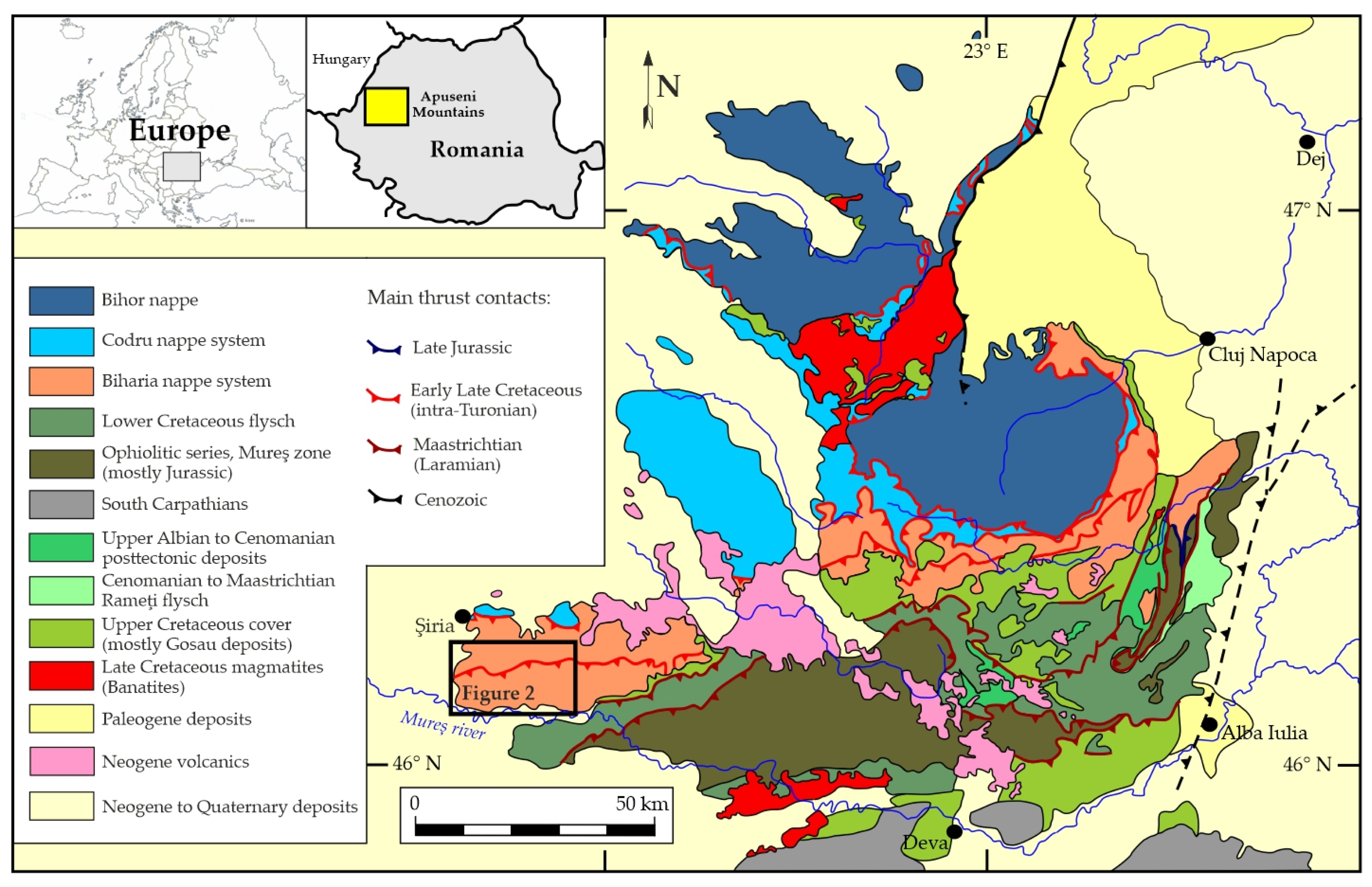

2. Geological Background
3. Materials and Methods
4. Results
4.1. Field Observations
4.2. XRPD Analyses
4.3. Petrography
4.4. Mineral Chemistry of Tourmaline
4.5. K–Ar Geochronology
5. Discussion
5.1. Main Metasomatic Effects and Paragenetic Sequence
5.2. Tentative Reconstruction of the Greisen System in the Study Area
5.3. Interpretation of the Age Data
6. Conclusions
- (1)
- Several characteristic features of albitization, sericitization, tourmalinization, epidotization, and hematitization were recognized in the studied samples. In the paragenetic sequence, three different hydrothermal episodes can be demonstrated: (i) crystallization of UST quartz, K-feldspar, and magnetite, representing the first stage during the magmatic-hydrothermal transition; (ii) the early and main stages of greisenization with a mineral assemblage of albite, ‘sericite’, schorl, and quartz; and (iii) the late vein-depositing stage with mineral assemblages of dravite, quartz, ‘specularite’, epidote, apatite and, subsequently, albite and mica.
- (2)
- Felsic rock samples contain at least two generations of tourmaline (group I tourmaline: schorl, group II tourmaline: dravite), supporting that these rocks were affected by multiple hydrothermal events. The country rocks also have disseminated tourmaline and tourmaline-quartz-dominated veins. Therefore, the study area could belong to a boron-rich open greisen system in the apical portion of the Highiş granite.
- (3)
- In the contact aureole, spotted schists with the presence of porphyroblastic biotite and cordierite occur. The observed mineralogical assemblages together with the petrographic features show that the thermal mineral assemblages were overprinted by greisenization. Furthermore, exogreisen deposits developed in both pelitic and mafic rocks in the study area.
- (4)
- Based on our results, the previously published Permian crystallization ages could be homogenized and/or partially rejuvenated during the hydrothermal mineralization processes. Additionally, the Highiș granite-related magmatic–hydrothermal system also suffered a Cretaceous thermal overprint.
Author Contributions
Funding
Data Availability Statement
Acknowledgments
Conflicts of Interest
Appendix A
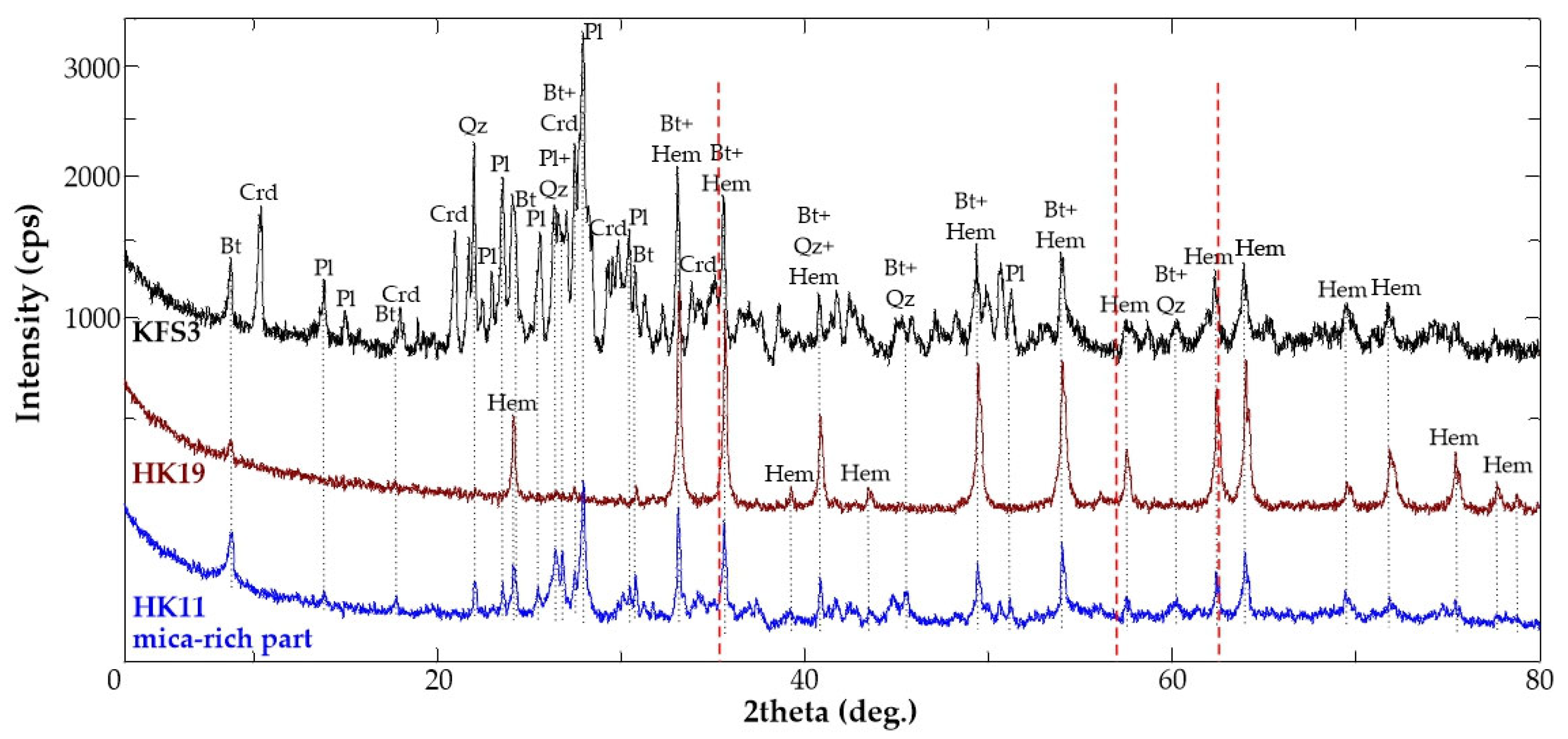
Appendix B
| Title | Tur I 1a | Tur I 1b | Tur I 1c | Tur I 1d | Tur I 1e | Tur I 1f | Tur I 2a | Tur I 2b |
|---|---|---|---|---|---|---|---|---|
| SiO2 | 35.1 | 35.08 | 34.82 | 35.68 | 35.78 | 35.56 | 34.54 | 34.57 |
| TiO2 | 0.68 | 0.58 | 0.62 | 0.56 | 0.84 | 0.82 | 1.15 | 1.2 |
| Al2O3 | 23.65 | 24.08 | 24.02 | 24.83 | 24.11 | 24.28 | 20.2 | 20.31 |
| FeO * | 12.68 | 12.97 | 12.37 | 12.44 | 12.06 | 12.14 | 15.36 | 15.75 |
| MgO | 8.89 | 8.63 | 9.23 | 8.64 | 9.3 | 9.2 | 8.97 | 8.91 |
| CaO | 1.92 | 1.6 | 1.96 | 1.51 | 2.05 | 1.89 | 2.63 | 2.76 |
| MnO | 0.09 | 0.05 | 0.05 | 0.06 | 0.05 | 0.06 | 0.12 | 0.1 |
| Na2O | 1.7 | 2.04 | 1.7 | 1.92 | 1.76 | 1.67 | 1.46 | 1.53 |
| K2O | 0 | 0.03 | 0 | 0.03 | 0.03 | 0 | 0.01 | 0.03 |
| H2O ** | 3.44 | 3.45 | 3.45 | 3.50 | 3.51 | 3.50 | 3.36 | 3.37 |
| B2O3 *** | 9.98 | 10.01 | 10.00 | 10.14 | 10.17 | 10.13 | 9.72 | 9.78 |
| Li2O **** | 0.00 | 0.00 | 0.00 | 0.00 | 0.00 | 0.00 | 0.00 | 0.00 |
| Total | 98.13 | 98.52 | 98.22 | 99.31 | 99.66 | 99.25 | 97.52 | 98.31 |
| Structural formula based on 31 anions (O, OH, F) | ||||||||
| Si | 6.11 | 6.09 | 6.05 | 6.12 | 6.12 | 6.10 | 6.17 | 6.14 |
| Al | 0.00 | 0.00 | 0.00 | 0.00 | 0.00 | 0.00 | 0.00 | 0.00 |
| ΣT | 6.11 | 6.09 | 6.05 | 6.12 | 6.12 | 6.10 | 6.17 | 6.14 |
| B | 3.00 | 3.00 | 3.00 | 3.00 | 3.00 | 3.00 | 3.00 | 3.00 |
| ΣB | 3.00 | 3.00 | 3.00 | 3.00 | 3.00 | 3.00 | 3.00 | 3.00 |
| Al | 4.86 | 4.93 | 4.92 | 5.02 | 4.86 | 4.91 | 4.26 | 4.25 |
| Mg | 1.15 | 1.07 | 1.08 | 0.98 | 1.14 | 1.09 | 1.75 | 1.75 |
| ΣZ | 6.00 | 6.00 | 6.00 | 6.00 | 6.00 | 6.00 | 6.00 | 6.00 |
| Al | 0.00 | 0.00 | 0.00 | 0.00 | 0.00 | 0.00 | 0.00 | 0.00 |
| Ti | 0.09 | 0.08 | 0.08 | 0.07 | 0.11 | 0.11 | 0.16 | 0.16 |
| Mg | 1.16 | 1.16 | 1.31 | 1.22 | 1.23 | 1.26 | 0.65 | 0.62 |
| Mn | 0.01 | 0.01 | 0.01 | 0.01 | 0.01 | 0.01 | 0.02 | 0.02 |
| Fe2+ | 1.85 | 1.88 | 1.80 | 1.78 | 1.72 | 1.74 | 2.30 | 2.34 |
| ΣY | 3.11 | 3.13 | 3.20 | 3.09 | 3.06 | 3.12 | 3.11 | 3.13 |
| Ca | 0.36 | 0.30 | 0.37 | 0.28 | 0.38 | 0.35 | 0.50 | 0.53 |
| Na | 0.57 | 0.69 | 0.57 | 0.64 | 0.58 | 0.56 | 0.51 | 0.53 |
| K | 0.00 | 0.01 | 0.00 | 0.01 | 0.01 | 0.00 | 0.00 | 0.01 |
| ΣX | 0.93 | 0.99 | 0.94 | 0.92 | 0.97 | 0.90 | 1.01 | 1.06 |
| OH | 4.00 | 4.00 | 4.00 | 4.00 | 4.00 | 4.00 | 4.00 | 4.00 |
| ΣV + W | 4.00 | 4.00 | 4.00 | 4.00 | 4.00 | 4.00 | 4.00 | 4.00 |
| Mineral name | Schorl | Schorl | Schorl | Schorl | Schorl | Schorl | Schorl | Schorl |
| Title | Tur II 3a 1 | Tur II 3b | Tur II 3c | Tur II 3d 1 | Tur II 3e | Tur II 3f | Tur II 3g 1 | Tur II 3h | Tur II 3i |
|---|---|---|---|---|---|---|---|---|---|
| SiO2 | 35.98 | 37.12 | 36.76 | 36.05 | 36.24 | 36.63 | 36.42 | 36.96 | 36.99 |
| TiO2 | 0.37 | 0.06 | 0.08 | 0.4 | 0.12 | 0.12 | 0.45 | 0.07 | 0.13 |
| Al2O3 | 27.76 | 32.19 | 32 | 28.64 | 31.13 | 31.25 | 29.5 | 32.05 | 32.15 |
| FeO * | 11.04 | 6.24 | 6.49 | 10.07 | 6.7 | 6.9 | 8.15 | 6.95 | 6.73 |
| MgO | 7.75 | 8.07 | 7.91 | 7.61 | 7.79 | 7.92 | 8.37 | 8.05 | 8.12 |
| CaO | 1.36 | 0.35 | 0.41 | 1.11 | 0.51 | 0.48 | 1.06 | 0.5 | 0.35 |
| MnO | 0.08 | 0.05 | 0.04 | 0 | 0.03 | 0 | 0.06 | 0.03 | 0.07 |
| Na2O | 2.1 | 2.44 | 2.54 | 2.18 | 2.39 | 2.47 | 2.31 | 2.41 | 2.42 |
| K2O | 0.01 | 0.04 | 0.02 | 0.03 | 0.02 | 0 | 0.02 | 0.03 | 0.01 |
| H2O ** | 3.57 | 3.70 | 3.68 | 3.58 | 3.62 | 3.65 | 3.63 | 3.71 | 3.71 |
| B2O3 *** | 10.35 | 10.73 | 10.67 | 10.39 | 10.49 | 10.58 | 10.53 | 10.74 | 10.75 |
| Li2O **** | 0.00 | 0.00 | 0.00 | 0.00 | 0.00 | 0.00 | 0.00 | 0.00 | 0.00 |
| Total | 100.38 | 101.00 | 100.60 | 100.06 | 99.03 | 100.00 | 100.50 | 101.50 | 101.43 |
| Structural formula based on 31 anions (O, OH, F) | |||||||||
| Si | 6.04 | 6.01 | 5.99 | 6.03 | 6.01 | 6.02 | 6.01 | 5.98 | 5.98 |
| Al | 0.00 | 0.00 | 0.01 | 0.00 | 0.00 | 0.00 | 0.00 | 0.02 | 0.02 |
| ΣT | 6.04 | 6.01 | 6.00 | 6.03 | 6.01 | 6.02 | 6.01 | 6.00 | 6.00 |
| B | 3.00 | 3.00 | 3.00 | 3.00 | 3.00 | 3.00 | 3.00 | 3.00 | 3.00 |
| ΣB | 3.00 | 3.00 | 3.00 | 3.00 | 3.00 | 3.00 | 3.00 | 3.00 | 3.00 |
| Al | 5.49 | 6.00 | 6.00 | 5.65 | 6.00 | 6.00 | 5.74 | 6.00 | 6.00 |
| Mg | 0.51 | 0.00 | 0.00 | 0.35 | 0.00 | 0.00 | 0.26 | 0.00 | 0.00 |
| ΣZ | 6.00 | 6.00 | 6.00 | 6.00 | 6.00 | 6.00 | 6.00 | 6.00 | 6.00 |
| Al | 0.00 | 0.14 | 0.13 | 0.00 | 0.08 | 0.05 | 0.00 | 0.09 | 0.11 |
| Ti | 0.05 | 0.01 | 0.01 | 0.05 | 0.02 | 0.02 | 0.06 | 0.01 | 0.02 |
| Mg | 1.43 | 1.95 | 1.92 | 1.55 | 1.93 | 1.94 | 1.80 | 1.94 | 1.96 |
| Mn | 0.01 | 0.01 | 0.01 | 0.00 | 0.00 | 0.00 | 0.01 | 0.00 | 0.01 |
| Fe2+ | 1.55 | 0.85 | 0.88 | 1.41 | 0.93 | 0.95 | 1.13 | 0.94 | 0.91 |
| ΣY | 3.04 | 2.95 | 2.95 | 3.01 | 2.95 | 2.95 | 2.99 | 2.99 | 3.00 |
| Ca | 0.25 | 0.06 | 0.07 | 0.20 | 0.09 | 0.08 | 0.19 | 0.09 | 0.06 |
| Na | 0.68 | 0.77 | 0.80 | 0.71 | 0.77 | 0.79 | 0.74 | 0.76 | 0.76 |
| K | 0.00 | 0.01 | 0.00 | 0.01 | 0.00 | 0.00 | 0.00 | 0.01 | 0.00 |
| ΣX | 0.93 | 0.84 | 0.88 | 0.91 | 0.86 | 0.87 | 0.93 | 0.85 | 0.82 |
| OH | 4.00 | 4.00 | 4.00 | 4.00 | 4.00 | 4.00 | 4.00 | 4.00 | 4.00 |
| ΣV + W | 4.00 | 4.00 | 4.00 | 4.00 | 4.00 | 4.00 | 4.00 | 4.00 | 4.00 |
| Mineral name | Schorl | Dravite | Dravite | Dravite | Dravite | Dravite | Dravite | Dravite | Dravite |
References
- Štemprok, M. Greisenization (a review). Geol. Rundsch. 1987, 76, 169–175. [Google Scholar] [CrossRef]
- Pirajno, F. Hydrothermal Processes and Mineral Systems; Springer Science + Business Media B.V.: Berlin/Heidelberg, Germany, 2009; pp. 205–259. [Google Scholar] [CrossRef]
- Pirajno, F. Effects of Metasomatism on Mineral Systems and Their Host Rocks: Alkali Metasomatism, Skarns, Greisens, Tourmalinites, Rodingites, Black-Wall Alteration and Listvenites. In Metasomatism and the Chemical Transformation of Rock; Harlov, D.E., Austrheim, H., Eds.; Lecture Notes in Earth System Sciences; Springer: Berlin/Heidelberg, Germany, 2013; pp. 203–251. [Google Scholar] [CrossRef]
- Müller, A.; Herklotz, G.; Giegling, H. Chemistry of quartz related to the Zinnwald/Cínovec Sn-W-Li greisen-type deposit, Eastern Erzgebirge, Germany. J. Geochem. Explor. 2018, 190, 357–373. [Google Scholar] [CrossRef]
- Mohammadi, N.; McFarlane, C.R.M.; Lentz, D.R. U–Pb Geochronology of Hydrothermal Monazite from Uraniferous Greisen Veins Associated with the High Heat Production Mount Douglas Granite, New Brunswick, Canada. Geosciences 2019, 9, 224. [Google Scholar] [CrossRef]
- Chen, L.-L.; Ni, P.; Dai, B.-Z.; Li, W.-S.; Chi, Z.; Pan, J.-Y. The Genetic Association between Quartz Vein- and Greisen-Type Mineralization at the Maoping W–Sn Deposit, Southern Jiangxi, China: Insights from Zircon and Cassiterite U–Pb Ages and Cassiterite Trace Element Composition. Minerals 2019, 9, 411. [Google Scholar] [CrossRef]
- Radvanec, M.; Gonda, S. Genetic model of Permian hydrothermal mineralization in Gemeric unit (W. Carpathians) from the deep-seated zone of anatectic melting to volcanic-exhalative SedEx mineralization on the surface. Miner. Slov. 2019, 52, 109–156. [Google Scholar]
- Tillberg, M.; Maskenskaya, O.M.; Drake, H.; Hogmalm, J.K.; Broman, C.; Fallick, A.E.; Åström, M.E. Fractionation of Rare Earth Elements in Greisen and Hydrothermal Veins Related to A-Type Magmatism. Geofluids 2019, 2019, 4523214. [Google Scholar] [CrossRef]
- Stoltnow, M.; Lüders, V.; de Graaf, S.; Niedermann, S. A geochemical study of the Sweet Home mine, Colorado Mineral Belt, USA: Formation of deep hydrothermal vein–type molybdenum greisen and base metal mineralization. Miner. Depos. 2022, 57, 801–825. [Google Scholar] [CrossRef]
- Bonin, B.; Tatu, M. Cl-rich hydrous mafic mineral assemblages in the Highiș massif, Apuseni Mountains, Romania. Miner. Petrol. 2016, 110, 447–469. [Google Scholar] [CrossRef]
- Szemerédi, M.; Varga, A.; Dunkl, I.; Lukács, R.; Seghedi, I.; Kovács, Z.; Raucsik, B.; Pál–Molnár, E. Petrology and zircon U–Pb dating of granitoid rocks in the Highiş massif (SW Apuseni Mts., Romania): Insights into Permian plutonic–volcanic connections. Geol. Carpath. 2021, 72, 482–504. [Google Scholar] [CrossRef]
- Ciobanu, C.L.; Cook, N.J.; Damian, F.; Damian, G. Gold scavenged by bismuth melts: An example from Alpine shear-remobilizates in the Highiș Massif, Romania. Miner. Petrol. 2006, 87, 351–384. [Google Scholar] [CrossRef]
- Bordea, S.; Bordea, J. Presence of the “Vermiculate Sandstone Formation” (Permian) in the central zone of the Highiş mountains. Rom. J. Stratigr. 1993, 75, 17–19. [Google Scholar]
- Bejenaru, C.; Cioloboc, D. Uranium exploration and production in Romania: Case histories and prospects. In Recent Developments in Uranium Resources and Supply; IAEA-TECDOC-823; International Atomic Energy Agency (IAEA): Vienna, Austria, 1995. [Google Scholar]
- Word Distribution of Uranium Deposits (UDEPO) with Uranium Deposit Classification; IAEA-TECDOC-1629; International Atomic Energy Agency (IAEA): Vienna, Austria. 2009. Available online: https://www-pub.iaea.org/mtcd/publications/pdf/te_1629_web.pdf (accessed on 21 May 2023).
- Kounov, A.; Schmid, S.M. Fission-track constraints on the thermal and tectonic evolution of the Apuseni Mountains (Romania). Int. J. Earth Sci. 2013, 102, 207–233. [Google Scholar] [CrossRef]
- Dallmeyer, R.D.; Pană, D.I.; Neubauer, F.; Erdmer, P. Tectonothermal evolution of the Apuseni Mountains, Romania; resolution of Variscan versus Alpine events with 40Ar/39Ar ages. J. Geol. 1999, 107, 329–352. [Google Scholar] [CrossRef]
- Balintoni, I.; Balica, C.; Cliveţi, M.; Li, L.Q.; Hann, H.P.; Chen, F.; Schuller, V. The emplacement age of the Muntele Mare Variscan granite (Apuseni Mountains, Romania). Geol. Carpath. 2009, 60, 495–504. [Google Scholar] [CrossRef]
- Papiu, C.V.; Ghenea, C. Geological Map of Romania, Arad Sheet 16, Scale: 1:200,000; Geological Institute of Romania: Bucharest, Romania, 1966. [Google Scholar]
- Pană, D.I.; Heaman, L.M.; Creaser, R.A.; Erdmer, P. Pre-Alpine crust in the Apuseni Mountains, Romania: Insights from Sm–Nd and U–Pb data. J. Geol. 2002, 110, 341–354. [Google Scholar] [CrossRef]
- Pană, D.I.; Ricman, C. The lower complex of the Paiuşeni series—A blastomylonitic shear belt. Rev. Roum. Géol. Géophys. Géogr. Géologie 1988, 32, 21–35. [Google Scholar]
- Pană, D.I.; Erdmer, P. Alpine crustal shear zones and pre-alpine basement terranes in the Romanian Carpathians and Apuseni Mountains. Geology 1994, 22, 807–810. [Google Scholar] [CrossRef]
- Whitney, D.L.; Evans, B.W. Abbreviations for names of rock-forming minerals. Am. Min. 2010, 95, 185–187. [Google Scholar] [CrossRef]
- Pouchou, J.-L.; Pichoir, F. A new model for quantitative X-ray micro-analysis. Rech. Aerosp. 1984, 3, 167–192. [Google Scholar]
- Selway, J.B.; Xiong, J. Tourmaline recalculation software (Excel spreadsheet: Tourmaline.xls). Tindle, A.G.; Breaks, F.W.; Selway, J.B. Tourmaline in petalite-subtype granitic pegmatites: Evidence of fractionation and contamination from the Pakeagama Lake and Separation Lake areas of northwestern Ontario, Canada. Can. Miner. 2002, 40, 753–788. [Google Scholar] [CrossRef]
- Henry, D.J.; Novák, M.; Hawthorne, F.C.; Ertl, A.; Dutrow, B.L.; Uher, P.; Pezzotta, F. Nomenclature of the tourmaline-supergroup minerals. Am. Min. 2011, 96, 895–913. [Google Scholar] [CrossRef]
- Matsumoto, A.; Kobayashi, T. K–Ar age determination of late Quaternary volcanic rocks using the “mass fractionation correction procedure”: Application to the Younger Ontake Volcano, central Japan. Chem. Geol. 1995, 125, 123–135. [Google Scholar] [CrossRef]
- Ottens, B.; Schuster, R.; Benkó, Z. The Secondary Minerals from the Pillow Basalt of Salsette-Mumbai, Deccan Volcanic Province, India. Minerals 2022, 12, 444. [Google Scholar] [CrossRef]
- Hess, J.C.; Lippolt, H.J. Compilation of K-Ar measurements on HDB-1 standard biotite. Status Report. In Phanerozoic Time Scale, Bulletin de Liaison et D’information; IUGS Subcommission on Geochronology: Paris, France, 1994; pp. 19–23. [Google Scholar]
- Gillot, P.-Y.; Cornette, Y.; Max, N.; Floris, B. Two Reference Materials, Trachytes Mdo-G and Ish-G, for Argon Dating (K-Ar and 40Ar/39Ar) of Pleistocene and Holocene Rocks. Geostand. Newsl. 1992, 16, 55–60. [Google Scholar] [CrossRef]
- Steiger, R.; Jäger, E. Subcommission on geochronology: Convention on the use of decay constants in geo and cosmochronology. Earth Planet. Sci. Lett. 1977, 36, 359–362. [Google Scholar] [CrossRef]
- Quidelleur, X.; Gillot, P.-Y.; Soler, V.; Lefèvre, J.C. K/Ar dating extended into the last millennium: Application to the youngest effusive episode of the Teide volcano (Spain). Geophys. Res. Lett. 2001, 28, 3067–3070. [Google Scholar] [CrossRef]
- Hanesch, M. Raman spectroscopy of iron oxides and (oxy)hydroxides at low laser power and possible applications in environmental magnetic studies. Geophys. J. Int. 2009, 177, 941–948. [Google Scholar] [CrossRef]
- Müller, A.; Kirwin, D.; Seltmann, R. Textural characterization of unidirectional solidification textures related to Cu–Au deposits and their implication for metallogenesis and exploration. Miner. Depos. 2023. [Google Scholar] [CrossRef]
- Zharikov, V.A.; Rusinov, V.L.; Marakushev, A.A.; Zaraisky, G.P.; Omelianenko, B.I.; Pertsev, N.N.; Rass, I.T.; Andreeva, O.V.; Abramov, S.S.; Podlessky, K.V.; et al. Metasomatism and Metasomatic Rocks, English Translation. 2015. Available online: https://archive.org/details/metasomatic_rocks_april_2015/mode/2up (accessed on 30 December 2022).
- Kubiš, M.; Broska, I. The role of boron and fluorine in evolved granitic rock systems (on the example of the Hnilec area, Western Carpathians). Geol. Carpath. 2005, 56, 193–204. Available online: http://www.geologicacarpathica.com/browse-journal/volumes/56-3/article-309/ (accessed on 21 May 2023).
- de Oliveira, L.A.R.; Rios, F.J.; Rosière, C.A.; Wälle, M.; Ortelli, M.; Kouzmanov, K. Nature and evolution of fluids associated with specularite-bearing Fe and Au-PGE (Jacutinga) mineralization during the Brasiliano orogeny in the eastern São Francisco Craton, Minas Gerais, Brazil. Ore Geol. Rev. 2017, 86, 130–153. [Google Scholar] [CrossRef]
- Liu, X.; Zhang, D.; Yang, J.; Xiao, C.; Zhang, T. High heat producing granites and prolonged extraction of tungsten and tin from melts. Geochim. Cosmochim. Acta 2023, 348, 340–354. [Google Scholar] [CrossRef]
- Hodges, K.V. Geochronology and Thermochronology in Orogenic Systems. In Treatise on Geochemistry; Rudnick, R.L., Holland, H.D., Turekian, K.K., Eds.; Elsevier: Oxford, UK, 2003; Volume 3, pp. 263–292. [Google Scholar] [CrossRef]
- Hunziker, J.C. The evolution of illite to muscovite: An example of the behaviour of isotopes in low-grade metamorphic terrains. Chem. Geol. 1986, 57, 31–40. [Google Scholar] [CrossRef]
- Hunziker, J.C.; Frey, M.; Clauer, N.; Dallmeyer, R.D.; Friedrichsen, H.; Flehmig, W.; Hochstrasser, K.; Roggwiler, P.; Schwander, H. The evolution of illite to muscovite: Mineralogical and isotopic data from the Glarus Alps, Switzerland. Contrib. Miner. Petrol. 1986, 92, 157–180. [Google Scholar] [CrossRef]
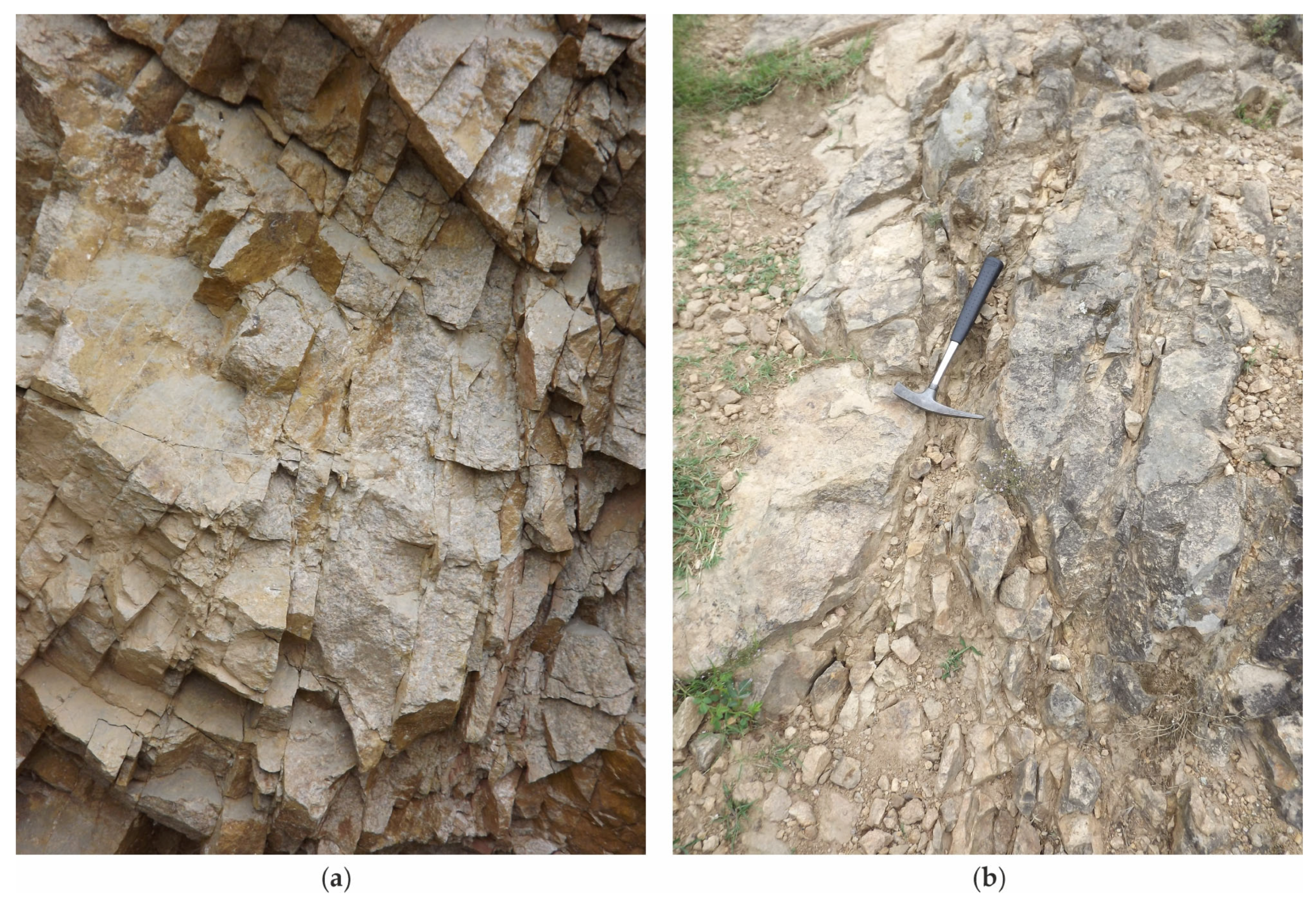

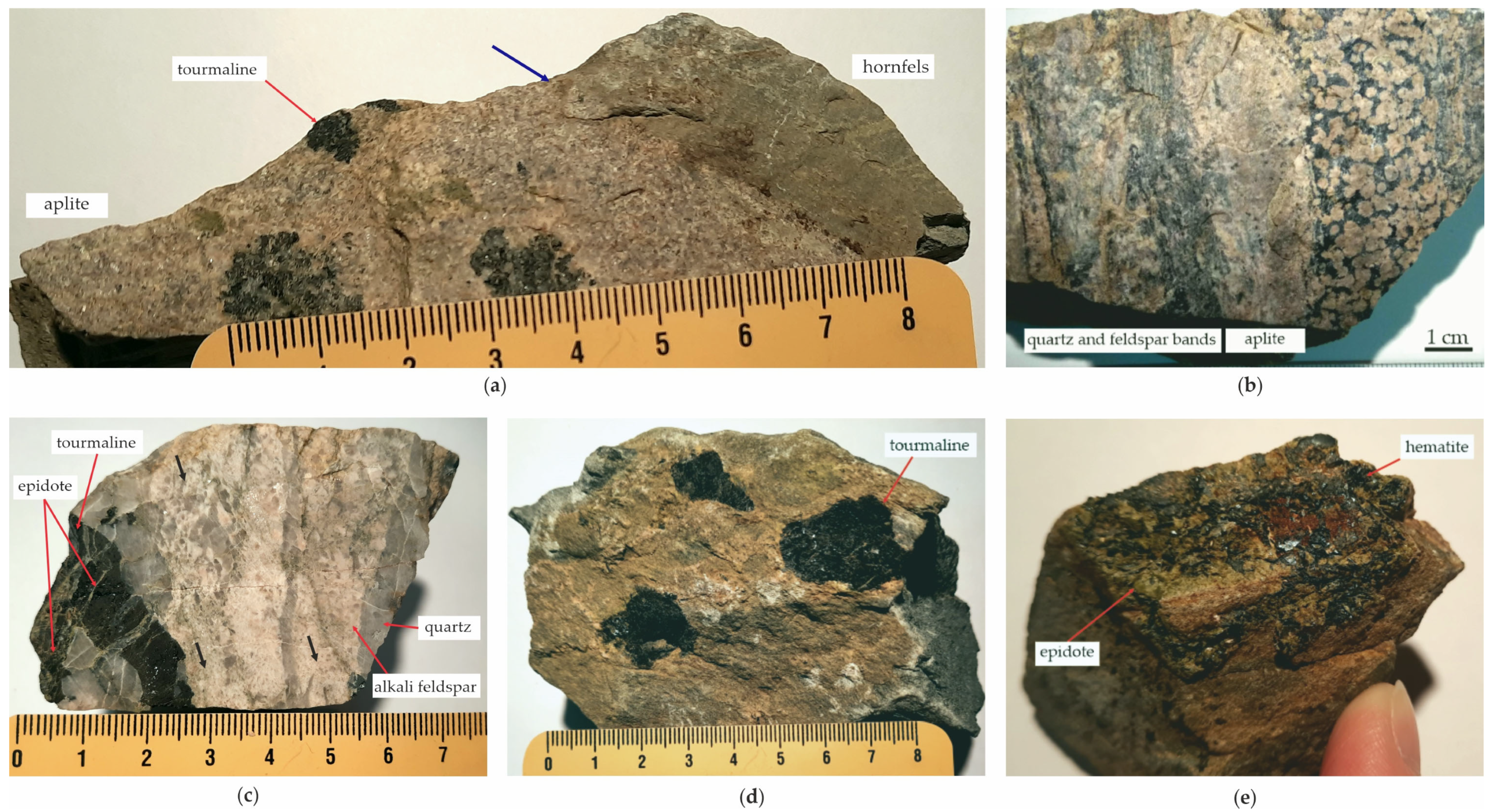
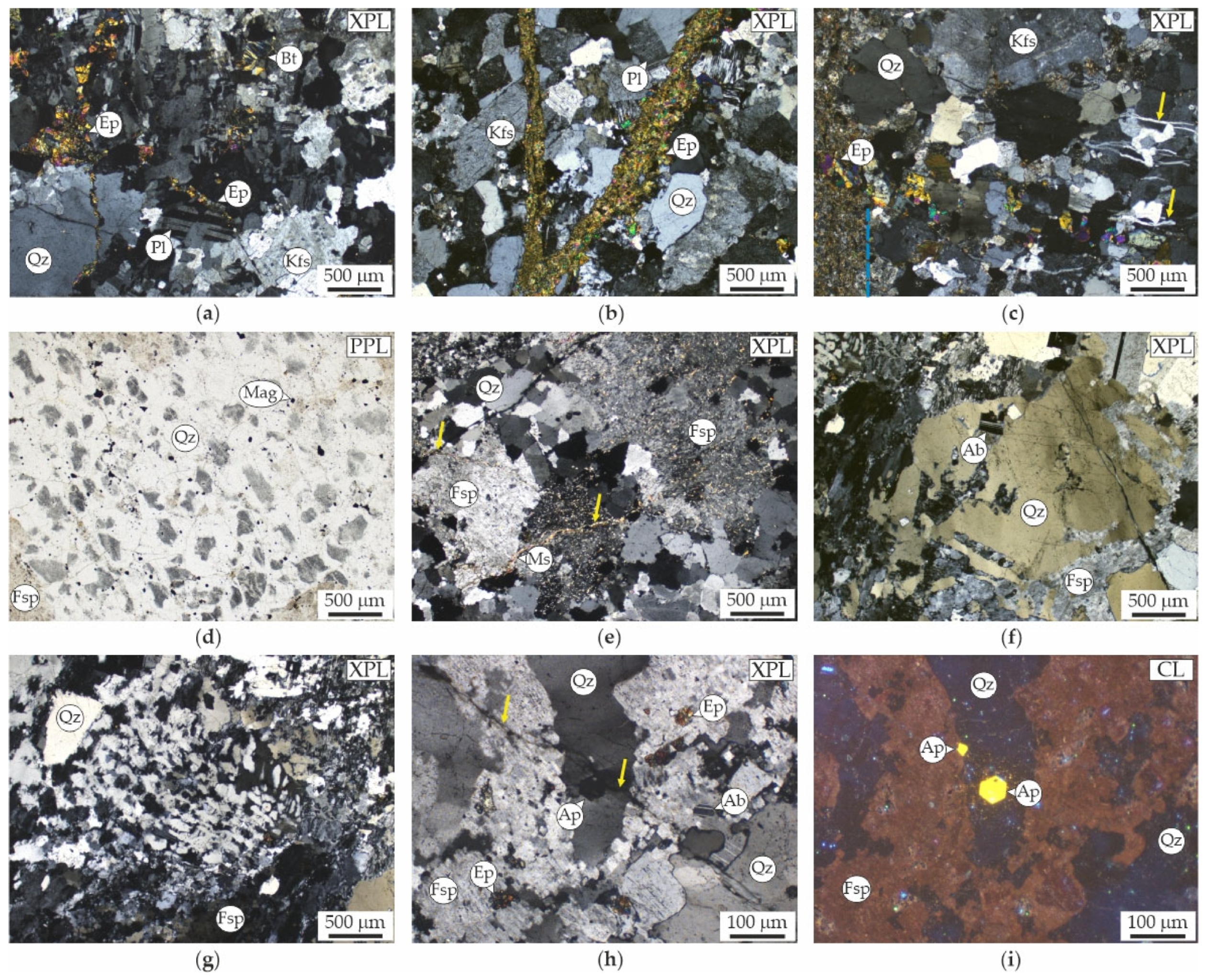
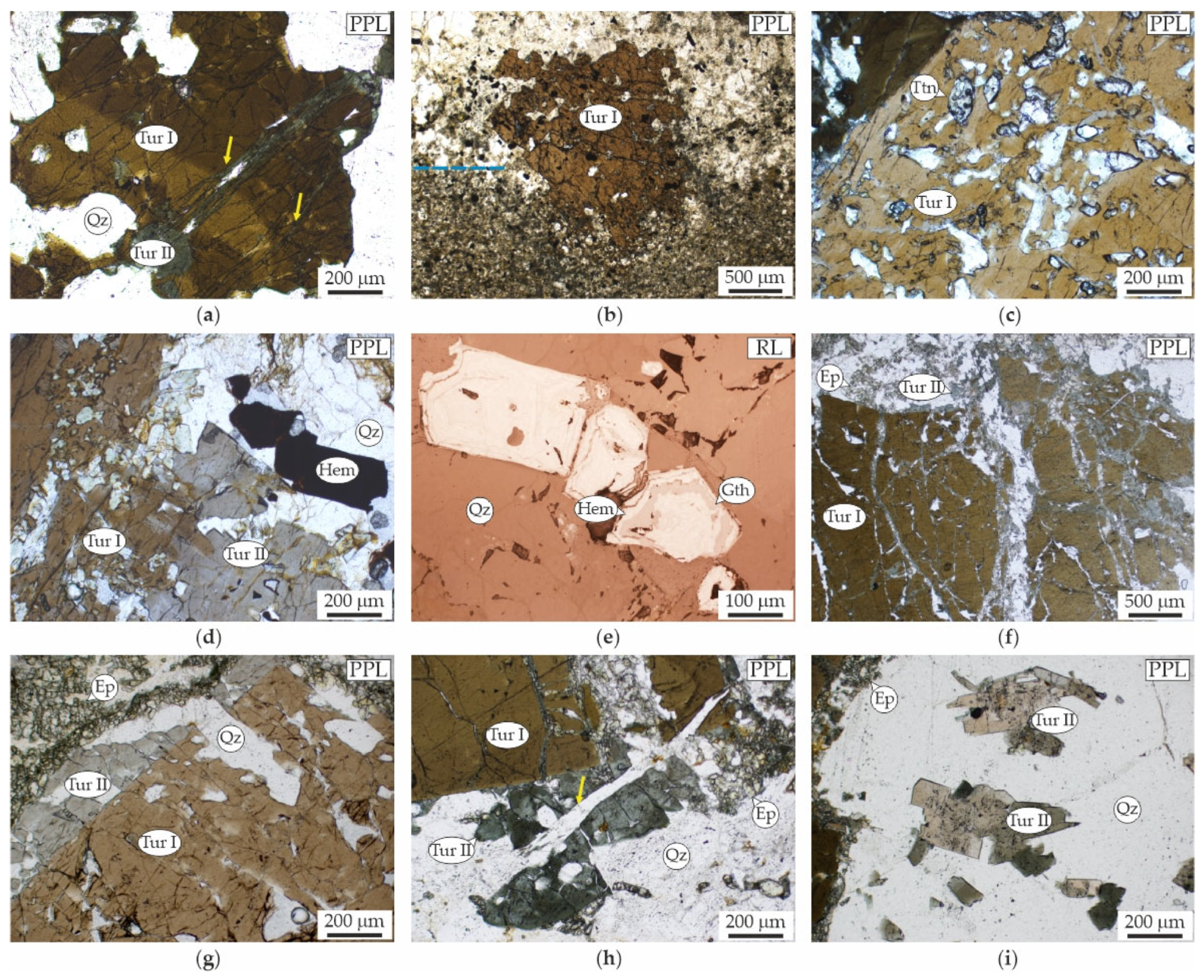



| Sampling Site/Type | Sample Code/Type | Minerals (~wt%) |
|---|---|---|
| KDK3 (granitoids) | HK2 granite (WR) 1 | Pl (40), Kfs (38), Qz (20), Cal (2) |
| HK2 tourmaline, nest | Qz (51), Tur (49) | |
| KDK3 (dykes/veins) | KDK3F (VM) 2 | Qz (63), Kfs (21), Pl (16) |
| KDK3T (VM) | Pl (68), Qz (32) | |
| KDK3T tourmaline | Qz (44), Tur (37), Ep (19) | |
| HK17 (WR excluding tourmaline) | Pl (82), Amp (12), Ms (6) | |
| HK18 (VM) | Hem (57), Ep (43) | |
| HK18 specularite | Ep (53), Hem (47) | |
| HK19 specularite | Hem (91), Bt (9) | |
| KDK3 (hornfels) | HK8 (WR) | Pl (76), Bt (22), Hem (2) |
| HK11 (WR) | Pl (65), Bt (21), Ms (14) | |
| HK11 light spots | Pl (51), Bt (46), Hem (3) | |
| HK11 mica-rich part | Pl (47), Hem (19), Qz (19), Bt (15) | |
| KDK2 (hornfels) | KDK2B (WR) | Ms (47), Qz (30), Chl (17), Hem (6) |
| KFS3 (WR) | Pl (63), Crd (15), Qz (12), Bt (5), Hem (5) | |
| KDK1 (country rocks) | KDK1L (WR) | Ms (52), Qz (22), Pl (20), Chl (6) |
| KDK1L clay fraction | Ilt ± Ms (65), Vrm ± Chl/Vrm (24), Kln (11) | |
| KDK1S (WR) | Qz (33), Pl (30), Ms (22), Chl (15) | |
| KDK1S clay fraction | Ilt ± Ms (49), Vrm ± Chl/Vrm (25), Chl (13), Kln (13) |
| Sample Type | Mineral | r 40Ar*/40Artot | 40Ar*/m ×10−6 [ccSTP/g] | K (wt%) | Age (Ma) |
|---|---|---|---|---|---|
| tourmaline HK17 | tourmaline + K-feldspar | 0.37 | 1.60 | 0.4 | 100.26 ± 1.44 |
| hornfels HK8 (WR) 1 | biotite (phlogopite) | 0.68 | 1.49 | 3.035 | 133.61 ± 1.90 |
| <2 μm fraction | 0.66 | 16.62 | 3.951 | 105.14 ± 1.50 | |
| <1 μm fraction | 0.41 | 15.08 | 3.813 | 98.96 ± 1.42 | |
| KDK1L (WR) | illite | 0.63 | 19.19 | 4.267 | 112.16 ± 1.60 |
| <2 μm fraction | 0.50 | 23.96 | 6.275 | 95.66 ± 1.37 | |
| KDK1S (WR) | illite | 0.15 | 2.70 | 0.53 | 126.37 ± 1.98 |
| <2 μm fraction | 0.40 | 12.50 | 3.205 | 97.68 ± 1.40 | |
| <1 μm fraction | 0.58 | 1.15 | 3.833 | 75.55 ± 1.08 |
Disclaimer/Publisher’s Note: The statements, opinions and data contained in all publications are solely those of the individual author(s) and contributor(s) and not of MDPI and/or the editor(s). MDPI and/or the editor(s) disclaim responsibility for any injury to people or property resulting from any ideas, methods, instructions or products referred to in the content. |
© 2023 by the authors. Licensee MDPI, Basel, Switzerland. This article is an open access article distributed under the terms and conditions of the Creative Commons Attribution (CC BY) license (https://creativecommons.org/licenses/by/4.0/).
Share and Cite
Varga, A.; Pozsár, A.; Zajzon, N.; Topa, B.; Benkó, Z.; Pál-Molnár, E.; Raucsik, B. Effects of Metasomatism on Granite-Related Mineral Systems: A Boron-Rich Open Greisen System in the Highiş Granitoids (Apuseni Mountains, Romania). Minerals 2023, 13, 1083. https://doi.org/10.3390/min13081083
Varga A, Pozsár A, Zajzon N, Topa B, Benkó Z, Pál-Molnár E, Raucsik B. Effects of Metasomatism on Granite-Related Mineral Systems: A Boron-Rich Open Greisen System in the Highiş Granitoids (Apuseni Mountains, Romania). Minerals. 2023; 13(8):1083. https://doi.org/10.3390/min13081083
Chicago/Turabian StyleVarga, Andrea, Attila Pozsár, Norbert Zajzon, Boglárka Topa, Zsolt Benkó, Elemér Pál-Molnár, and Béla Raucsik. 2023. "Effects of Metasomatism on Granite-Related Mineral Systems: A Boron-Rich Open Greisen System in the Highiş Granitoids (Apuseni Mountains, Romania)" Minerals 13, no. 8: 1083. https://doi.org/10.3390/min13081083
APA StyleVarga, A., Pozsár, A., Zajzon, N., Topa, B., Benkó, Z., Pál-Molnár, E., & Raucsik, B. (2023). Effects of Metasomatism on Granite-Related Mineral Systems: A Boron-Rich Open Greisen System in the Highiş Granitoids (Apuseni Mountains, Romania). Minerals, 13(8), 1083. https://doi.org/10.3390/min13081083







